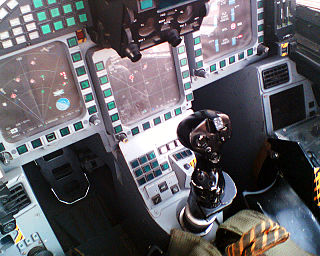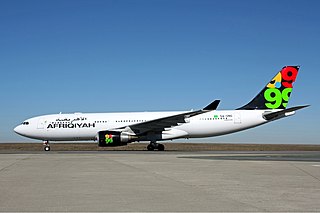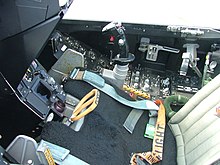
Fly-by-wire (FBW) is a system that replaces the conventional manual flight controls of an aircraft with an electronic interface. The movements of flight controls are converted to electronic signals transmitted by wires, and flight control computers determine how to move the actuators at each control surface to provide the ordered response. Implementations either use mechanical flight control backup systems or else are fully electronic.

The Airbus A330 is a wide-body aircraft developed and produced by Airbus. Airbus conceived several derivatives of the A300, its first airliner from the mid-1970s. Then the company began development on the A330 twinjet in parallel with the A340 quadjet and launched both designs with their first orders in June 1987. The A330-300, the first variant, took its maiden flight in November 1992 and entered service with Air Inter in January 1994. The slightly shorter A330-200 variant followed in 1998.

Libyan Airlines, formerly known as Libyan Arab Airlines over several decades, is the flag carrier of Libya. Based in Tripoli, it operates scheduled passenger and cargo services within Libya and to Europe, North Africa and the Middle East, the majority of which leave from Tripoli International Airport. Benina International Airport in Benghazi serves as a secondary base. Libyan Airlines also operates Hajj services. The company is wholly owned by the government of Libya.

A conventional fixed-wing aircraft flight control system (AFCS) consists of flight control surfaces, the respective cockpit controls, connecting linkages, and the necessary operating mechanisms to control an aircraft's direction in flight. Aircraft engine controls are also considered flight controls as they change speed.

Afriqiyah Airways is a Libyan airline based in Tripoli, Libya. It was established in 2001 and operates both domestic and international flights. The airline's main hub is Tripoli International Airport (TIP), and it serves a wide range of destinations across Africa, the Middle East, and Europe.
Armavia was an airline that existed between 1996 and 2013. It was Armenia's flag carrier, with its head office on the grounds of Zvartnots International Airport in Zvartnots, Armenia, near Yerevan. It operated international passenger services from Yerevan to destinations in Europe and Asia. Its main base was Zvartnots International Airport.

A yoke, alternatively known as a control wheel or a control column, is a device used for piloting some fixed-wing aircraft.

Pilot error generally refers to an accident in which an action or decision made by the pilot was the cause or a contributing factor that led to the accident, but also includes the pilot's failure to make a correct decision or take proper action. Errors are intentional actions that fail to achieve their intended outcomes. The Chicago Convention defines the term "accident" as "an occurrence associated with the operation of an aircraft [...] in which [...] a person is fatally or seriously injured [...] except when the injuries are [...] inflicted by other persons." Hence the definition of "pilot error" does not include deliberate crashing.

Mitiga International Airport is an airport that serves Tripoli, Libya, located about 8 kilometres east of Tripoli's city centre. Since 2018 it has been the sole international airport serving Tripoli following the closure of Tripoli International Airport after it was severely damaged in the second Libyan civil war.

Armavia Flight 967 was a scheduled international passenger flight operated by Armavia from Zvartnots International Airport, Zvarnots in Armenia to Sochi, a Black Sea coastal resort city in Russia. On 3 May 2006, the aircraft operating the route, an Airbus A320-200, crashed into the sea while attempting a go-around following its first approach to Sochi airport; all 113 aboard were killed. The accident was the first major commercial airline crash in 2006. It was Armavia's only fatal crash during the airline's existence.

Indian Airlines Flight 605 was a scheduled domestic passenger flight from Bombay to Bangalore. On 14 February 1990, an Airbus A320-231 registered as VT-EPN, crashed onto a golf course while attempting to land at Bangalore, killing 92 of 146 people on board.

A centre stick, or simply control stick, is an aircraft cockpit arrangement where the control column is located in the center of the cockpit either between the pilot's legs or between the pilots' positions. Since the throttle controls are typically located to the left of the pilot, the right hand is used for the stick, although left-hand or both-hands operation is possible if required.

Flight envelope protection is a human machine interface extension of an aircraft's control system that prevents the pilot of an aircraft from making control commands that would force the aircraft to exceed its structural and aerodynamic operating limits. It is used in some form in all modern commercial fly-by-wire aircraft. The professed advantage of flight envelope protection systems is that they restrict a pilot's excessive control inputs, whether in surprise reaction to emergencies or otherwise, from translating into excessive flight control surface movements. Notionally, this allows pilots to react quickly to an emergency while blunting the effect of an excessive control input resulting from "startle," by electronically limiting excessive control surface movements that could over-stress the airframe and endanger the safety of the aircraft.

Air France Flight 447 (AF447/AFR447) was a scheduled international passenger flight from Rio de Janeiro, Brazil, to Paris, France. On 1 June 2009, inconsistent airspeed indications led to the pilots inadvertently stalling the Airbus A330 serving the flight. They failed to recover the plane from the stall, and the plane crashed into the mid Atlantic Ocean at 02:14 UTC, killing all 228 passengers and crew on board.

A flight control mode or flight control law is a computer software algorithm that transforms the movement of the yoke or joystick, made by an aircraft pilot, into movements of the aircraft control surfaces. The control surface movements depend on which of several modes the flight computer is in. In aircraft in which the flight control system is fly-by-wire, the movements the pilot makes to the yoke or joystick in the cockpit, to control the flight, are converted to electronic signals, which are transmitted to the flight control computers that determine how to move each control surface to provide the aircraft movement the pilot ordered.

Afriqiyah Airways Flight 771 was a scheduled international Afriqiyah Airways passenger flight that crashed on 12 May 2010 at about 06:01 local time on approach to Tripoli International Airport, about 1,200 metres short of the runway. Of the 104 passengers and crew on board, 103 were killed. The sole survivor was a 9-year-old Dutch boy. The crash of Flight 771 was the third hull-loss of an Airbus A330 involving fatalities, occurring eleven months after the crash of Air France Flight 447.

Asiana Airlines Flight 162 was a regular short-haul international passenger flight from Incheon International Airport near Seoul, South Korea, to Hiroshima Airport in Hiroshima, Japan. On 14 April 2015, the Airbus A320-232 aircraft touched down short of the runway, struck the localizer array, skidded onto the runway on its tail, and spun 120 degrees before finally coming to a rest on the grass, opposite the terminal building. The aircraft suffered substantial damage to the left wing and engine. Of the 82 people aboard, 27 were injured, one seriously.

Iberia Flight 1456 was a domestic scheduled flight from Barcelona-El Prat Airport, Spain, to Bilbao Airport, Spain. On Wednesday, February 7, 2001, the Airbus A320, which took off from Barcelona-El Prat Airport, Spain, encountered a microburst-induced wind shear on final approach to Bilbao Airport, Spain. The wind shear caused the plane's landing gear to collapse. All 143 passengers onboard survived; with 25 people suffering light injuries, and 1 person receiving serious injuries. The aircraft was irreparably damaged as a result of the ordeal and was decommissioned soon after, making it the ninth loss of an Airbus A320 at that time. This accident prompted Airbus to develop a fail-safe modification for its flight control software by preventing the airplane's built-in protection against stall from being activated by a high rate of change for the angle of attack.


















